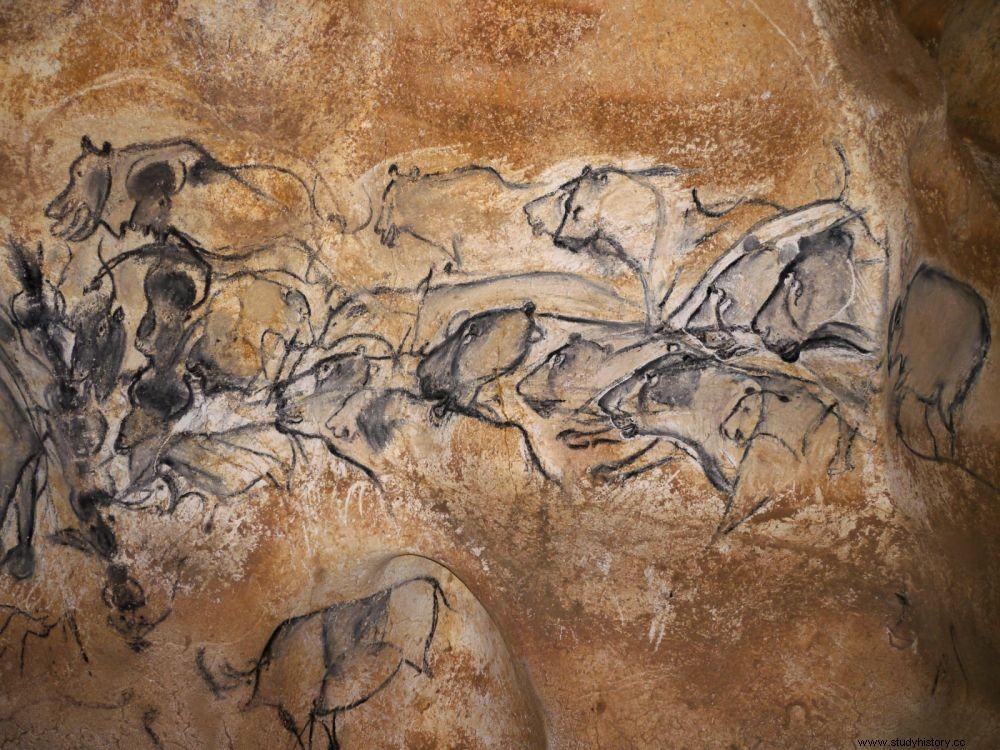Until June 7, 2020, the film "The Last Passage", 3D images of the Chauvet cave made in 2015, can be seen free of charge and unlimited on a dedicated platform. In these strange times of pandemic, "art and storytelling play a crucial role in our societies" insists the prehistorian Jean-Michel Geneste.

The panel of Lions, in the Chauvet-Pont d'Arc cave, (Ardèche).
First, everything is black because, “in the beginning, there is black”. Then, very slowly, very calmly, our gaze, as if hypnotized, follows a range of light which reveals the walls of the cave. Because, in these times of confinement / pre-déconfinement, what better than a deep cave to have this strange feeling, sometimes frightening, sometimes reassuring, of being entirely immersed in a space whose exit even seems to have disappeared? Here, we are at the heart of the Chauvet cave (1), where humans painted 36,000 years ago. Let yourself be guided by this cone of light which makes certain floors shine like so many thousands of set diamonds, which here reveals the design of the muzzle of this "master of darkness" that is the bear, "sacred animal"; there, the horn of a violent rhinoceros confronting a fellow rhino; further on, a moving human hand with contours revealed by stencil-style blown ocher powder.
Prehistorian Jean-Michel Geneste, friend of Sciences et Avenir , co-creator of the film "The Last Passage", made in 2015, informed us that the extraordinary 3D images, which he helped to produce, visible in a single sequence shot of approximately half an hour, would be available free until June 7, 2020 on the MissingMatter.info website or www.taraexpo.com.
"Everything in the cave expresses a living thought"
More than a virtual visit (2), it is an invitation to an inner journey, because "everything in the cave expresses a living thought", murmurs the voice of Anouk Grinberg (in English, the commentary is said by Marianne Faithfull, who was sick with the coronavirus...) on a text by the French prehistorian, general heritage curator, who was at the origin of the 3D digitization programs for the caves of Lascaux and Chauvet. Let us be led into this immersive experience, touch heavy draperies of bronze stone, caress from afar the mounds-stalagmites of virginal white, carefully cross sparkling stalactites as sharp as daggers. Vibrant music accompanies this almost sleepwalking progress, all the more enveloping as the commentary stops almost halfway through the film, leaving us alone with the sound frequencies and our reverie, eyes wide open on the past of 'Homo Sapiens.
Our ancestor here omnipresent seems almost familiar to us, although invisible. So close to nature and so close to the spirits... "The light that creates forms favors the coming of the spirits", says Jean-Michel Geneste's commentary. The one created by our ancestors with their flickering flame grease lamps was no exception to this rule.
"A living being from this planet, a new virus, a microscopic and invisible being, has just reminded us of the fragility of the human species", wrote the promoters of the platform (quoted above) on which the film can be viewed , recalling that in two months, 3 billion human beings have been affected by the presence of the coronavirus. Above all, they point out “this health crisis reveals what has already been broken. The pandemic emphasizes that “nature” does not think. She is exuberant, wild and cruel. It is humans who have the prerogative of thought, and it is up to them not to manage nature, but to respect it and seek a balance with the myriad of other living beings whose existence we share”.
The cohesion of human groups
In the cave, the perception of time is changing, as many confined people have felt in recent days and nights... In its countless nooks, more and more surprises are hidden. It is a “strange and secret landscape, linked to another world, another time, another reality”. Before the deconfinement of May 11, 2020 and its expectations which can both delight and worry, there is no reason to deprive yourself of going now to meet (in just half an hour) these extraordinary horses and lionesses from the Chauvet cave. Perhaps more than the paintings we admire today on glossy paper or in museums, these depictions must have played a crucial role in human groups 36,000 years ago. Ensure their cohesion. Turn into pledges of survival. Who wouldn't need it today too?
1) Discovered in December 1994 as part of private speleological activities by Jean-Marie Chauvet, Christian Hillaire and Eliette Brunel, the Chauvet Pont d'Arc cave, a UNESCO World Heritage Site, is not open to the public. A replica has been made which has not ceased to be a great tourist success since its opening in April 2015.
2) “In the context of this pandemic and the various national confinements, while rock art sites and their facsimiles are closed to the public, producer Martin Marquet has taken the initiative to invite director Pascal Magontier , Jean-Michel Geneste and the Rock Art network to partner with him to give away the images of the film "The Last Passage". The music is by Damien Vandesande and Clément Aichelbaum.
